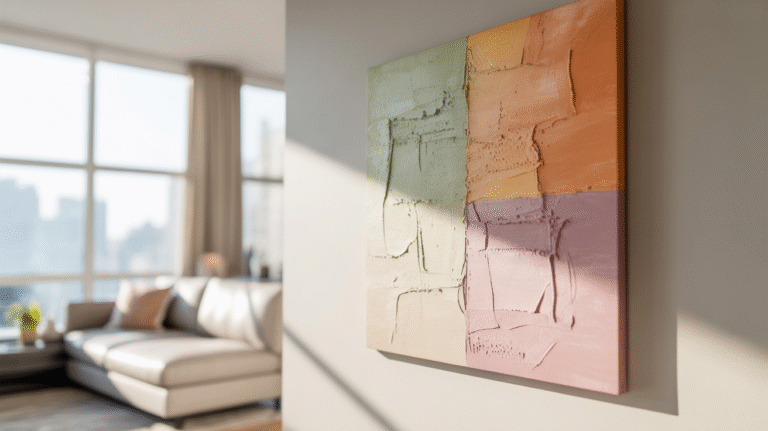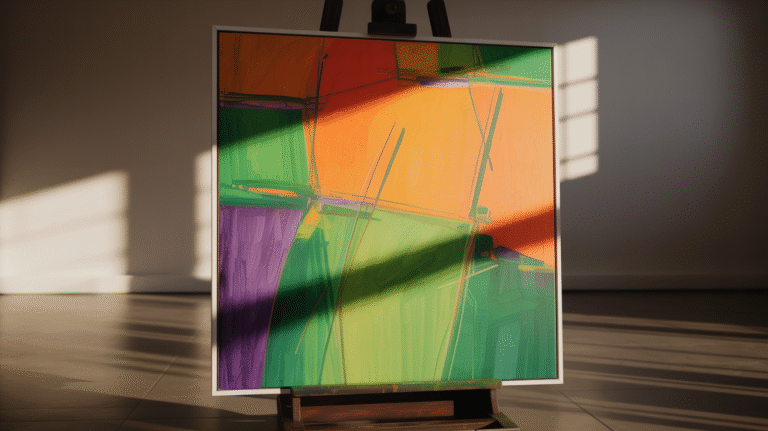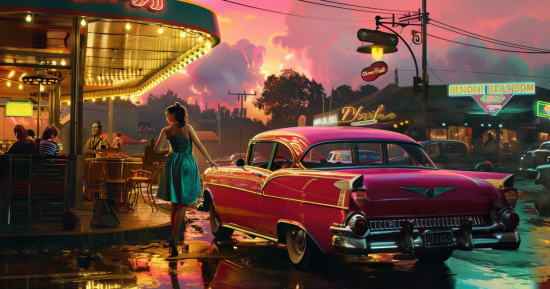Art isn’t just about what you see – it’s about what you feel, too. Texture in art adds a whole new layer of meaning and makes your work come alive. Whether it’s rough, smooth, soft, or bumpy, texture helps tell a story. In this article, you’ll learn what texture in art really is, how artists use it, and how you can try it yourself at home.
What Is Texture in Art?
Texture in art means how something looks or feels. There are two main types: tactile (you can touch it) and visual (it looks like it has texture, but it’s flat). Both types make your art more interesting.
Defining Texture in Art

Tactile Texture
Tactile texture is all about how a surface actually feels when you touch it. Artists can create this kind of texture by using thick paint, fabric, sand, or other materials. A rough texture might feel wild and bold, while a smooth one can feel calm and clean. Adding real texture helps your art stand out and gives the viewer something extra to connect with.
Visual Texture
Visual texture looks like it has a feel, even if it doesn’t. It’s an illusion. Artists use lines, dots, shapes, and shadows to make something look textured. For example, a drawing might look like wood or fabric, even if the paper is completely flat. This kind of texture is great for painting and drawing because it makes flat art feel alive.
Why Texture Matters in Art
Texture makes your artwork more interesting. It helps guide the viewer’s eye, sets the mood, and makes your piece more exciting. You can use texture to create balance – heavy textures feel strong and grounded, while light textures feel soft or dreamy. You can also use texture to draw attention to certain parts of your work and to build contrast between different areas.
Common Texture Techniques
Here are some fun and easy ways artists add texture to their work:
- Dry Brush – Use a dry brush with little paint to make scratchy, broken lines
- Stippling – Add small dots or marks to show depth and texture
- Hatching – Use short lines to build shading and form
- Collage – Glue fabric, paper, or other materials for 3D effects
- Impasto – Layer paint thickly so it stands out from the canvas
Texture in Different Art Styles
Many famous art styles use texture in special ways. In Impressionism, artists like Claude Monet used short, thick brushstrokes to show movement and light. In Abstract Art, texture is used for strong feelings and wild shapes. In Realism and Hyperrealism, texture helps make things look just like real life – skin, fabric, water, or even glass.
Texture in Digital Art and Photography
Even in digital art and photos, texture plays a big role. In photography, side lighting or close-up shots can show texture clearly – like wood grain or fabric. In digital painting, artists use texture brushes and layers in apps to make digital work feel rich and deep.

Sculpture and Relief
When it comes to sculpture and relief, texture is paramount since these art forms rely on the physical touch and feel of their materials to resonate with the audience. Material choices, such as wood, metal, stone, or clay, can drastically influence the texture in a sculpture or relief. You can carve or mold materials with different tools, like hammers, chisels, or rasps, to create diverse textural experiences, reinforcing the intended message or emotions of your work.
| Material | Texture |
|---|---|
| Wood | Organic, grainy, warm |
| Metal | Smooth, cool, reflective |
| Stone | Rough, cool, solid |
| Clay | Soft, malleable, earthy |
Creating Texture in Artwork

Traditional Techniques to Create Texture in Art
Traditional art techniques are hands-on methods that artists have used for many years. They let you feel the texture with your hands and see it in the artwork. These are perfect if you love working with paint, pencils, paper, or real tools.
Here are some of the most popular traditional ways to add texture to your art:
- Impasto is when you use thick layers of paint on the canvas. You can do this with a brush or a palette knife. The paint stands out from the surface, so you can see and feel the texture.
Try this: Use a lot of paint and push it around with a knife – let it be messy and bold! - Dry Brush Technique is when you use a dry brush with only a little paint. It leaves scratchy, broken marks on the surface, which look rough and worn.
Try this: Wipe most of the paint off your brush, then drag it lightly over your canvas or paper. - Hatching and Cross-Hatching: Use straight lines (hatching) or overlapping lines (cross-hatching) to build up texture and shading. It’s great for drawings and ink sketches.
Try this: Draw short, neat lines close together to make one area look dark or fuzzy. - Stippling means adding many small dots to your paper or canvas. The closer the dots are, the darker the area looks.
Try this: Use a pen, pencil, or marker to make little dots – it takes time, but looks awesome! - Collage: Cut out pieces of fabric, paper, string, or other materials and glue them to your artwork. This adds real texture you can feel.
Try this: Use old magazines, tissue paper, lace, or fabric scraps to build a 3D surface. - Sgraffito is when you scratch into a surface to reveal the layer underneath. It works well with oil pastels or thick paint.
Try this: Cover your paper with one color, then paint a darker color on top. While it’s wet, scratch a design through the top layer. - Salt and Watercolor: Sprinkle salt on wet watercolor paint. The salt absorbs some of the color and leaves cool, grainy patterns behind.
Try this: Paint a sky or background with watercolor, then shake salt on top before it dries. Watch the texture appear! - Textured Tools: Artists often use tools besides brushes: sponges, combs, forks, even crumpled plastic wrap. These tools leave behind unique textures.
Try this: Dab paint with a sponge, drag a comb through wet paint, or press plastic wrap onto the surface. - Mixed Materials: You can also mix things into your paint, like sand, coffee grounds, or even thread to make a surface that feels rough or grainy.
Try this: Mix a little fine sand into acrylic paint for a gritty, cool texture.
Modern and Digital Techniques
Exploring modern and digital techniques for creating texture can offer new possibilities and make your artwork even more dynamic. Here are some ideas:
- Use Texture Brushes: Most drawing apps have special texture brushes that look like chalk, watercolor, spray paint, or fabric. These brushes can make your art look soft, grainy, rough, or scratchy.
Try this: In Procreate, explore the “Charcoal” or “Spraypaint” brush sets to add cool textures with just a swipe. - Overlay Textures: You can place a real texture photo (like wood, fabric, or paper) on top of your digital drawing and set the layer to “Overlay” or “Multiply.” This adds a natural texture look without drawing it from scratch.
Try this: Download a free paper texture and place it over your artwork. Change the layer mode to see how it blends. - Layer and Blend: Use layers to add different parts of your drawing. On each layer, try different brushes and textures. You can blur or blend them to soften the look.
- Create Your Own Texture Brush: Some apps let you make your own brushes. You can draw a pattern or scan a real texture and turn it into a custom brush.
Try this: Take a photo of a fabric or crumpled paper, turn it black-and-white, and import it into your art app to use as a brush base.
Try this: Add shadows on a new layer using a soft airbrush. Then use a textured brush on top to make it feel more real. - Play with Pressure and Opacity: Many drawing tablets respond to how hard you press. Light pressure makes a soft stroke; heavy pressure makes it darker or thicker. Lowering brush opacity also builds soft layers of texture.
Try this: Use light pressure to sketch with a pencil brush, then press harder to add bold, textured lines. - Photography: Take close-up photos of real textures like tree bark, stone, or fabric, and use them as part of your artwork. This works great for backgrounds or special effects.
Try this: Use a photo of denim or canvas as a texture behind a fashion illustration.
Texture in Artistic Movements and Styles
Impressionism
Impressionist artists, like Claude Monet or Mary Cassatt, didn’t try to paint perfect details. Instead, they used short, thick brushstrokes to capture light, color, and movement. These brushstrokes left behind a soft, touchable texture on the canvas.
What it feels like: Airy, dreamy, light – like a breeze in a flower garden.
Try it: Use dabs of color and let your brush marks show. Don’t blend everything!
Abstract Art
In Abstract Art, texture is a big part of how artists express feelings. They often use big shapes, bold colors, and layered textures to make the viewer feel something – even if the picture doesn’t show a clear object.
Artists like: Wassily Kandinsky, Joan Mitchell, or even modern mixed media artists.
What it feels like: Loud, wild, emotional – like a storm or a dance.
Try it: Use your hands, palette knives, or textured brushes. Let your feelings guide you.
Realism and Hyperrealism
In Realism, artists try to show the world exactly how it looks. In Hyperrealism, the goal is to make art look even more real than real life! That means getting the textures just right – whether it’s soft skin, shiny glass, or wrinkled fabric.
Artists like: Chuck Close, Alyssa Monks
What it feels like: Exact, detailed, focused – like zooming in with a camera.
Try it: Look very closely at what you’re drawing. Use layers and soft textures to copy what you see.
Expressionism
Expressionist artists used texture to show deep emotions like fear, anger, or sadness. They often used thick paint, fast strokes, or dark textures to express how they felt inside.
Artists like: Edvard Munch, Egon Schiele
What it feels like: Raw, messy, powerful – like a scream or a heavy heart.
Try it: Don’t be afraid to use rough textures or dark colors. Let the emotion lead your hand.
Understanding how artists use texture helps you connect with their work, and your own! You don’t need to copy these styles, but you can learn from them. Try combining your favorite ideas from each and make something that feels like you.
How do you perceive texture in works of art? Feel free to share your experiences in the comments.
What is texture in art for children?
It’s how something feels or looks like it would feel – smooth, rough, soft, bumpy, etc.
How do artists use texture?
They use it to make their art feel real, emotional, or exciting. Texture adds depth and movement.
What does texture feel like?
It can be soft, rough, scratchy, smooth, or bumpy – just like things in the real world.
Now that you know how powerful texture in art can be, try adding it to your own artwork! Follow us on Pinterest for more creative texture ideas, or share your favorite techniques in the comments below. Let your art not just be seen – but felt.






